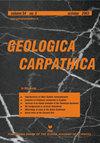Influence of fluid flows on low-temperature thermochronology: An example from the Podhale Basin, Internal Western Carpathians, Poland
IF 1.5
4区 地球科学
Q4 GEOSCIENCES, MULTIDISCIPLINARY
引用次数: 0
Abstract
: A novel approach that couples hydrological and thermochronological modelling is tested in a well-known hydrothermal system, the Inner Western Carpathians, providing insights of the yet-unexplained Apatite Fission Track (AFT) ages of the Podhale Basin. Our new model improves previous ones by incorporating the effects of fluid circulation, by considering compaction, smectite dehydration and meteoric water as sources of fluid. Rock properties such as thermal diffusivity, porosity and permeability, are dependent on lithology and the effective-stress state of the system, making our calculations depart from previous efforts on thermochronological modelling. Particularly, we examined young (around 12 Ma) apatite fission track ages from Oligocene strata of the Podhale wild flysch, which suggest the occurrence of either substantial burial or an elevated basal thermal paleogradient, even though none of the above have been documented in the area. Such problem is addressed on this contribution, since by reproducing previous numerical experiments but adding groundwater circulation this time, improved thermally-reset AFT ages of the Podhale Basin are obtained. Thermal, hydrological and mineralogical observations are successfully reproduced, putting forward the calibration and validity of the model here proposed. Furthermore, our findings not only unveil the linking between the hydrological and thermal phenomena present in the study region, but also, trigger new questions on the processes that should be taken into account when thermochronological calculations are concerned. comparison: with (fluid model or FM) and without (no fluid model or NFM) fluid flow, representing the former the model proposed by (Sanchez et al. 2021), and the latter the kine-matically-based models used to date. To couple hydrological and thermal calculations, a convective term to the diffusion– advection heat equation was added流体流动对低温热年代学的影响:以波兰西喀尔巴阡山脉内部Podhale盆地为例
一种结合水文和热年代学模型的新方法在一个著名的热液系统中进行了测试,内西部喀尔巴阡山脉,为Podhale盆地尚未解释的磷灰石裂变径迹(AFT)年龄提供了见解。我们的新模型改进了以前的模型,考虑了流体循环的影响,考虑了压实、蒙脱石脱水和大气水作为流体的来源。岩石性质,如热扩散率、孔隙度和渗透率,取决于岩性和系统的有效应力状态,这使得我们的计算与以前的热年代学建模不同。特别是,我们检查了Podhale野生复理石渐新世地层中年轻(约12 Ma)磷灰石裂变径迹年龄,这表明存在大量埋藏或升高的基底热古梯度,尽管该地区没有上述记录。这一贡献解决了这一问题,因为通过复制以前的数值实验,但这次增加了地下水循环,得到了Podhale盆地的热重置AFT年龄的改进。通过对热、水文和矿物学观测资料的成功再现,验证了模型的定标性和有效性。此外,我们的发现不仅揭示了研究区域存在的水文和热现象之间的联系,而且还引发了有关热年代学计算时应考虑的过程的新问题。比较:有(流体模型或FM)和没有(没有流体模型或NFM)流体流动,代表前者是(Sanchez et al. 2021)提出的模型,后者是迄今为止使用的基于运动学的模型。为了将水文和热计算结合起来,在扩散-平流热方程中加入了对流项
本文章由计算机程序翻译,如有差异,请以英文原文为准。
求助全文
约1分钟内获得全文
求助全文
来源期刊

Geologica Carpathica
地学-地球科学综合
CiteScore
2.40
自引率
23.10%
发文量
26
审稿时长
>12 weeks
期刊介绍:
GEOLOGICA CARPATHICA covers a wide spectrum of geological disciplines including geodynamics, tectonics and structural geology, volcanology, stratigraphy, geochronology and isotopic geology, karstology, geochemistry, mineralogy, petrology, lithology and sedimentology, paleogeography, paleoecology, paleobiology and paleontology, paleomagnetism, magnetostratigraphy and other branches of applied geophysics, economic and environmental geology, experimental and theoretical geoscientific studies. Geologica Carpathica , with its 60 year old tradition, presents high-quality research papers devoted to all aspects not only of the Alpine-Carpathian-Balkanian geoscience but also with adjacent regions originated from the Mediterranean Tethys and its continental foreland. Geologica Carpathica is an Official Journal of the Carpathian-Balkan Geological Association.
 求助内容:
求助内容: 应助结果提醒方式:
应助结果提醒方式:


